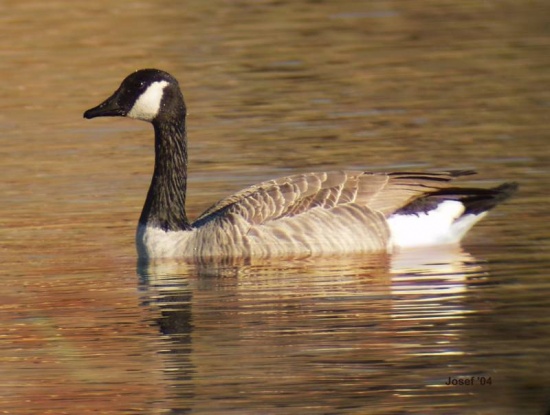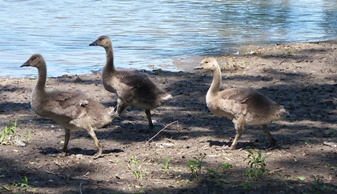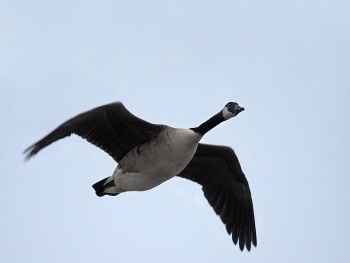(Video link. Reference updated) |
Sbarnhardt (talk | contribs) (Move Daddylion juvenile image to Similar Species, Move jbpixels Goslings image to Identification) |
||
| (12 intermediate revisions by 6 users not shown) | |||
| Line 1: | Line 1: | ||
| − | [[Image:Canada_Goose.jpg|thumb|550px|right|Photo by {{user|Josef|Josef}}<br />Cayon Lake, Rapid City, [[South Dakota]], [[USA]]]] | + | [[Image:Canada_Goose.jpg|thumb|550px|right|Photo © by {{user|Josef|Josef}}<br />Cayon Lake, Rapid City, [[South Dakota]], [[USA]]]] |
;[[:Category:Branta|Branta]] canadensis | ;[[:Category:Branta|Branta]] canadensis | ||
==Identification== | ==Identification== | ||
| − | + | [[File:Canada-Goose_Goslings_JBPXL.jpg|thumb|350px|right|Goslings<br />Photo © by {{user|jbpixels|jbpixels}}<br />Munich, [[Germany]], 25 April 2024]] | |
| − | *Light | + | Length 75–112 cm (29–44 in), wingspan 145–180 cm, weight 3–5 kg |
| + | *Light (eastern & central subspecies) to dark (western subspecies) brown body | ||
*Black neck and head with white chinstrap | *Black neck and head with white chinstrap | ||
*Breast lighter than the rest of the body | *Breast lighter than the rest of the body | ||
*White vent | *White vent | ||
*Black tail | *Black tail | ||
| + | *Large (4.1–5.7 cm) black bill | ||
| + | |||
| + | ====Similar species==== | ||
| + | [[Image: Canada_Geese_(goslings)opus.JPG|thumb|350px|right|Juveniles<br />Photo © by {{user|Daddylion|Daddylion}} <br /> Grand Rapids, [[Michigan]], June, 2009]] | ||
| + | [[Cackling Goose]] has very similar plumage pattern and colour, but differs in smaller overall size (60–70 cm), and most importantly, a small, stubby bill (2.8–3.8 cm bill length), in these features being more like [[Barnacle Goose]]. | ||
==Distribution== | ==Distribution== | ||
| − | [[North America]] and [[ | + | [[Image:IMG 00421.jpg|thumb|350px|right|Photo © by {{user|Macswede|Macswede}}<br />Hornborgasjön, [[Sweden]], March, 2010]] |
| + | [[North America]] ([[Canada]], [[United States]], [[Greenland]], and reaching northernmost [[Mexico]] in winter). | ||
| + | |||
| + | Vagrant in western [[Europe]] ([[Iceland]], [[Ireland]], [[Great Britain]]; involving ''B. c. interior'', ''B. c. canadensis'' and ''B. c. parvipes'') and eastern [[Asia]] (northeastern [[Russia]], [[Japan]], northeastern [[China]]). | ||
| − | Widespread feral populations throughout [[Europe]] | + | Widespread feral populations, mostly of ''B. c. canadensis'', throughout much of [[Europe]] and in [[New Zealand]], derived from escapes or releases from wildfowl collections. |
| − | |||
==Taxonomy== | ==Taxonomy== | ||
| − | + | Four very small, short-billed subspecies formerly included in Canada Goose were split as a separate species [[Cackling Goose]] in 2004, when genetic data showed they were more closely related to [[Barnacle Goose]] than to Canada Goose. | |
| − | ====Subspecies<sup>[[#References|[1]]]</sup> | + | ====Subspecies==== |
| − | + | Seven subspecies are currently accepted<sup>[[#References|[1]]]</sup><sup>[[#References|[2]]]</sup>: | |
| − | *''B. c. | + | *''B. c. canadensis'' - '''Atlantic Canada Goose''' |
| − | *''B. c. interior'' - | + | :*Breeds in [[Newfoundland]] and [[Labrador]] |
| − | + | *''B. c. interior'' - '''Hudson Bay Canada Goose''' | |
| − | *''B. c. | + | :*Breeds in northeastern [[Canada]] to [[Greenland]] |
| − | **Breeds in | + | *''B. c. maxima'' - '''Giant Canada Goose''' |
| − | *''B. c. | + | :*Breeds in interior eastern United States and southeastern Canada |
| − | + | *''B. c. moffitti'' - '''Great Basin Canada Goose''' | |
| − | + | :*Breeds in interior western United States and southwestern Canada | |
| − | *''B. c. occidentalis'' - Dusky Canada Goose | + | *''B. c. parvipes'' - '''Lesser Canada Goose''' |
| − | * | + | :*Breeds in central [[Alaska]] and interior northwestern Canada |
| − | *''B. c. fulva'' - | + | *''B. c. occidentalis'' - '''Dusky Canada Goose''' |
| − | * | + | :*Breeds in coastal [[Alaska]] (Anchorage region) |
| − | + | *''B. c. fulva'' - '''Vancouver Canada Goose''' | |
| − | + | :*Breeds in coastal southeastern [[Alaska]] and [[British Columbia]] | |
| + | |||
| + | The exact subspecies breeding ranges are becoming difficult to define due to extensive overlap and interbreeding between the subspecies following population increases in the 20th century. Wintering ranges are even more difficult to define, with considerable mixing between the subspecies. In general, migration follows a [[Dictionary_G-L#L|leapfrog pattern]], with the northernmost breeding birds (e.g. central [[Alaska]]) migrating the furthest south (as far as northern [[Mexico]]), while birds breeding at the southern edge of the breeding range (e.g. Tennessee) only migrate short distances if at all. | ||
| + | |||
| + | Populations of ''B. c. maxima'' came close to extinction in the early 1900s due to over-hunting, but have now recovered fully, helped by extensive reintroductions<sup>[[#References|[2]]]</sup>. | ||
| + | |||
==Habitat== | ==Habitat== | ||
Typically wetlands and farmland, occasionally urban settings. | Typically wetlands and farmland, occasionally urban settings. | ||
| Line 40: | Line 53: | ||
====Vocalisation==== | ====Vocalisation==== | ||
Male and female pair off with ''ahonk'' and ''hink'', respectively, while in flight. | Male and female pair off with ''ahonk'' and ''hink'', respectively, while in flight. | ||
| − | + | {{ Audio|Branta canadensis (song).mp3 }} | |
| − | + | ||
==References== | ==References== | ||
| − | #{{Ref- | + | #{{Ref-Clements6thAug16}}#Sibley, D. (2004). [http://www.sibleyguides.com/2007/07/identification-of-cackling-and-canada-goose/ Distinguishing Cackling and Canada Goose]. |
| + | #Wikipedia | ||
| + | #[http://www.dof.dk/sider/images/stories/doft/dokumenter/doft_3_2012_canada_goose_in_greenland.pdf "Canada Goose"] types in Greenland | ||
{{ref}} | {{ref}} | ||
==External Links== | ==External Links== | ||
| − | {{GSearch|Branta | + | {{GSearch|"Branta canadensis" {{!}} "Canada Goose"}} |
| + | {{GS-checked}}1 | ||
| + | <br /> | ||
<br /> | <br /> | ||
| − | |||
| − | [[Category:Birds]] [[Category:Branta]] [[Category:Bird Songs | + | [[Category:Birds]] [[Category:Branta]] [[Category:Bird Songs]] |
Latest revision as of 13:45, 2 May 2024
- Branta canadensis
Identification
Length 75–112 cm (29–44 in), wingspan 145–180 cm, weight 3–5 kg
- Light (eastern & central subspecies) to dark (western subspecies) brown body
- Black neck and head with white chinstrap
- Breast lighter than the rest of the body
- White vent
- Black tail
- Large (4.1–5.7 cm) black bill
Similar species
Cackling Goose has very similar plumage pattern and colour, but differs in smaller overall size (60–70 cm), and most importantly, a small, stubby bill (2.8–3.8 cm bill length), in these features being more like Barnacle Goose.
Distribution
North America (Canada, United States, Greenland, and reaching northernmost Mexico in winter).
Vagrant in western Europe (Iceland, Ireland, Great Britain; involving B. c. interior, B. c. canadensis and B. c. parvipes) and eastern Asia (northeastern Russia, Japan, northeastern China).
Widespread feral populations, mostly of B. c. canadensis, throughout much of Europe and in New Zealand, derived from escapes or releases from wildfowl collections.
Taxonomy
Four very small, short-billed subspecies formerly included in Canada Goose were split as a separate species Cackling Goose in 2004, when genetic data showed they were more closely related to Barnacle Goose than to Canada Goose.
Subspecies
Seven subspecies are currently accepted[1][2]:
- B. c. canadensis - Atlantic Canada Goose
- Breeds in Newfoundland and Labrador
- B. c. interior - Hudson Bay Canada Goose
- B. c. maxima - Giant Canada Goose
- Breeds in interior eastern United States and southeastern Canada
- B. c. moffitti - Great Basin Canada Goose
- Breeds in interior western United States and southwestern Canada
- B. c. parvipes - Lesser Canada Goose
- Breeds in central Alaska and interior northwestern Canada
- B. c. occidentalis - Dusky Canada Goose
- Breeds in coastal Alaska (Anchorage region)
- B. c. fulva - Vancouver Canada Goose
- Breeds in coastal southeastern Alaska and British Columbia
The exact subspecies breeding ranges are becoming difficult to define due to extensive overlap and interbreeding between the subspecies following population increases in the 20th century. Wintering ranges are even more difficult to define, with considerable mixing between the subspecies. In general, migration follows a leapfrog pattern, with the northernmost breeding birds (e.g. central Alaska) migrating the furthest south (as far as northern Mexico), while birds breeding at the southern edge of the breeding range (e.g. Tennessee) only migrate short distances if at all.
Populations of B. c. maxima came close to extinction in the early 1900s due to over-hunting, but have now recovered fully, helped by extensive reintroductions[2].
Habitat
Typically wetlands and farmland, occasionally urban settings.
Behaviour
Breeding
The nest is placed near water. The clutch of 3-8 eggs is laid in a shallow depression lined with plant material and down. Incubation takes 25–28 days.
Diet
The diet includes green vegetation, grains, aquatic plants, sometimes small insects and fish.
Vocalisation
Male and female pair off with ahonk and hink, respectively, while in flight.
References
- Clements, J. F., T. S. Schulenberg, M. J. Iliff, D. Roberson, T. A. Fredericks, B. L. Sullivan, and C. L. Wood. 2016. The eBird/Clements checklist of birds of the world: v2016, with updates to August 2016. Downloaded from http://www.birds.cornell.edu/clementschecklist/download/
- Sibley, D. (2004). Distinguishing Cackling and Canada Goose.
- Wikipedia
- "Canada Goose" types in Greenland
Recommended Citation
- BirdForum Opus contributors. (2024) Canada Goose. In: BirdForum, the forum for wild birds and birding. Retrieved 10 November 2024 from https://www.birdforum.net/opus/Canada_Goose
External Links
GSearch checked for 2020 platform.1







